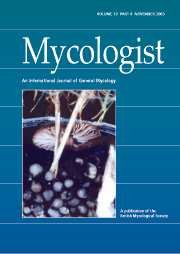Article contents
Phytophthora ramorum, the cause of sudden oak death or ramorum leaf blight and dieback
Published online by Cambridge University Press: 24 December 2004
Extract
In 1993, a new species of Phytophthora was first recognised as the cause of a disease killing both nursery and mature rhododendrons in Germany and The Netherlands. The same fungus was observed attacking Viburnum in 1998 in Germany. It was named as P. ramorum in 2001 (Werres et al., 2001).
Since 1995, a disease of native coastal oaks (Quercus and Lithocarpus spp.) has been observed in California and Oregon. A Phytophthora species was isolated from affected bark in 2000 and also confirmed as P. ramorum in 2001 (Rizzo et al., 2002). The disease caused by P. ramorum was named in the American popular press ‘sudden oak death’ following the extensive mortality caused by this fungus on the native Californian oaks (Rizzo et al., 2002). Since then the name of the disease has remained but with the increasing number of different hosts from which P. ramorum has been isolated and the range of symptoms, names such as ‘ramorum dieback’ and ‘ramorum leaf blight’ have been used to refer to the disease. The latin name ‘ramus’, meaning ‘branch’ refers to the pathogenicity of the fungus on branches (Werres et al., 2001).
The disease has been found in the following countries: Belgium, Canada, Denmark, France, Germany, Ireland, The Netherlands, Poland (interceptions), Norway, Slovenia, Spain, Sweden, UK, USA (California, Oregon and Washington). It is believed that the fungus has been introduced independently to northern Europe and western USA from an unidentified third country, i.e. it is not regarded as indigenous in either USA or Europe based on the recent discovery of the fungus, the differences in the population of the fungus between the two continents and the clonal structure of the sub-populations (Brasier, 2003; Rizzo & Garbelotto, 2003).
- Type
- Original Article
- Information
- Copyright
- © 2004 The British Mycological Society
- 13
- Cited by


